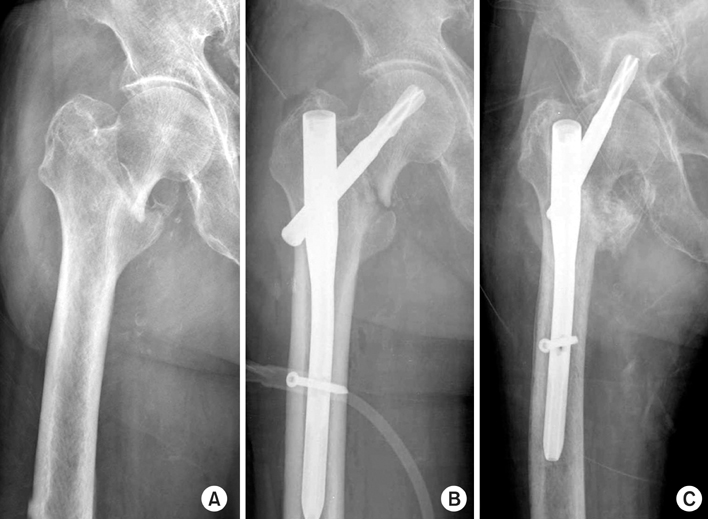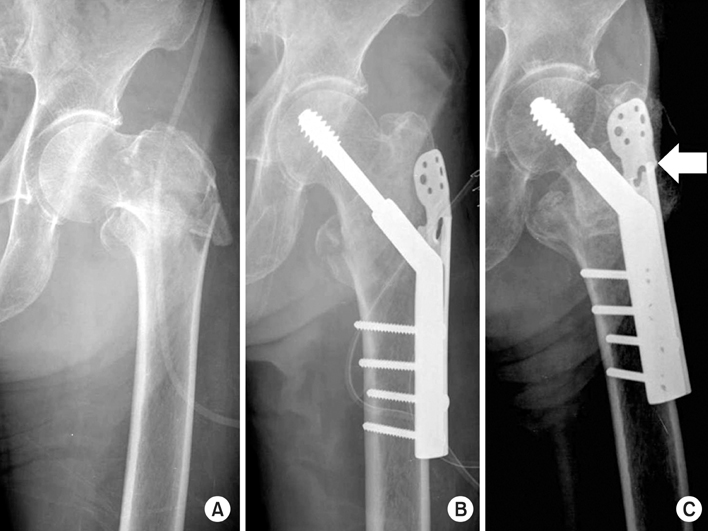Articles
- Page Path
- HOME > J Musculoskelet Trauma > Volume 23(2); 2010 > Article
-
Original Article
- Proximal Femoral Nail Antirotation versus Compression Hip Screw with Trochanter Stabilizing Plate for Unstable Intertrochanteric Hip Fractures
- Jae-Young Rho, M.D., Sang-Bum Kim, M.D., Youn-Moo Heo, M.D., Seong-Jin Cho, M.D., Dong-Sik Chae, M.D., Woo-Suk Lee, M.D.
-
Journal of the Korean Fracture Society 2010;23(2):161-166.
DOI: https://doi.org/10.12671/jkfs.2010.23.2.161
Published online: April 30, 2010
Department of Orthopedic Surgery, Konyang University College of Medicine, Daejeon, Korea.
*Department of Orthopedic Surgery, Yonsei University College of Medicine, Seoul, Korea.
- Address reprint requests to: Woo-Suk Lee, M.D. Department of Orthopedic Surgery, College of Medicine, Yonsei University, Gangnam Severance Hospital, 712, Eonju-ro, Gangnam-gu, Seoul 135-720, Korea. Tel: 82-2-2019-3417, Fax: 82-2-573-5393, wsleeos@kyuh.co.kr
Copyright © 2010 The Korean Fracture Society
- 751 Views
- 1 Download
- 3 Crossref
Abstract
-
Purpose
- To analyze and compare the clinical and radiologic results of treatments in unstable intertrochanteric fractures of the femur with proximal femoral nail antirotation (PFNA) and compression hip screw with trochanter stabilizing plate (CHS with TSP).
-
Materials and Methods
- We retrospectively reviewed the results of 66 cases of unstable intertrochanteric fractures of the femur treated with PFNA (Group I) and CHS with TSP (Group II) which could be followed up for minimum a year. We evaluated several comparative factors such as operation time, blood loss, time to bone union, changes in neck-shaft angle, sliding of screw (or blade), complications, postoperative pain, social-function score of Jensen, and mobility score of Parker and Palmer.
-
Results
- Group I showed shorter operation time and less blood loss with significance than group II (p<0.05), but there were no differences between the groups in the mean time to bone union, changes in neck-shaft angle, sliding of screw (or blade), complications, postoperative pain, and social-function score of Jensen (p>0.05). Two cases of cutting out of the blade through the femoral head were found in group I. One case of cutting out of the screw, one case of the breakage of the plate, and loosening of the plate were found in group II as complications.
-
Conclusion
- We think that there were no significant differences between PFNA and CHS with TSP in view point of radiologic and clinical outcomes in unstable intertrochanteric fractures of the femur, but PFNA is less invasive device than CHS with TSP, therefore it may be useful device in elderly patients.
- 1. Adams CI, Robinson CM, Court-Brown CM, McQueen MM. Prospective randomized controlled trial of an intramedullary nail versus dynamic screw and plate for intertrochanteric fractures of the femur. J Orthop Trauma, 2001;15:394-400.Article
- 2. Albareda J, Laderiga A, Palanca D, Paniagua L, Seral F. Complications and technical problems with the gamma nail. Int Orthop, 1996;20:47-50.ArticlePDF
- 3. Aune AK, Ekeland A, Odegaard B, Grøgaard B, Alho A. Gamma nail vs compression screw for trochanteric femoral fractures. 15 reoperations in a prospective, randomized study of 378 patients. Acta Orthop Scand, 1994;65:127-130.Article
- 4. Babst R, Renner N, Biedermann M, et al. Clinical results using the trochanter stabilizing plate (TSP): the modular extension of the dynamic hip screw (DHS) for internal fixation of selected unstable intertrochanteric fractures. J Orthop Trauma, 1998;12:392-399.Article
- 5. Bonamo JJ, Accettola AB. Treatment of intertrochanteric fractures with a sliding nail-plate. J Trauma, 1982;22:205-215.Article
- 6. Brunner A, Jöckel JA, Babst R. The PFNA proximal femur nail in treatment of unstable proximal femur fractures--3 cases of postoperative perforation of the helical blade into the hip joint. J Orthop Trauma, 2008;22:731-736.Article
- 7. Jensen JS. Classification of trochanteric fractures. Acta Orthop Scand, 1980;51:803-810.Article
- 8. Kang SY, Lee EW, Kang KS, et al. Mode of fixation failures of dynamic hip screw with TSP in the treatment of unstable proximal femur fracture: biomechanical analysis and a report of 3 cases. J Korean Orthop Assoc, 2006;41:176-180.ArticlePDF
- 9. Kim YC, An KC, Kim KY, et al. Treatment of osteoporotic unstable intertrochanteric fractures: comparative study between using dynamic hip screw and additional trochanter stabilizing plate. J Korean Orthop Assoc, 2005;40:741-748.ArticlePDF
- 10. Koval KJ, Sala DA, Kummer FJ, Zuckerman JD. Postoperative weight-bearing after a fracture of the femoral neck or an intertrochanteric fracture. J Bone Joint Surg Am, 1998;80:352-356.Article
- 11. Kyle RF, Gustilo RB, Premer RF. Analysis of six hundred and twenty-two intertrochanteric hip fractures. J Bone Joint Surg Am, 1979;61:216-221.Article
- 12. Lee JY, Lee SY. Treatment of the proximal femoral extracapsular fracture with proximal femoral nail antirotation (PFNA) - Comparison with proximal femoral nail (PFN) -. J Korean Hip Soc, 2007;19:183-189.
- 13. Lunsjö K, Ceder L, Stigsson L, Hauggaard A. One-way compression along the femoral shaft with the Medoff sliding plate. The first European experience of 104 intertrochanteric fractures with a 1-year follow-up. Acta Orthop Scand, 1995;66:343-346.Article
- 14. Madsen JE, Naess L, Aune AK, Alho A, Ekeland A, Strømsøe K. Dynamic hip screw with trochanteric stabilizing plate in the treatment of unstable proximal femoral fractures: a comparative study with the Gamma nail and compression hip screw. J Orthop Trauma, 1998;12:241-248.Article
- 15. Medoff RJ, Maes K. A new device for the fixation of unstable pertrochanteric fractures of the hip. J Bone Joint Surg Am, 1991;73:1192-1199.Article
- 16. Mereddy P, Kamath S, Ramakrishnan M, Malik H, Donnachie N. The AO/ASIF proximal femoral nail antirotation (PFNA): a new design for the treatment of unstable proximal femoral fractures. Injury, 2009;40:428-432.
- 17. Park MS, Lim YJ, Kim YS, Kim KH, Cho HM. Treatment of the proximal femoral fractures with proximal femoral nail antirotation (PFNA). J Korean Fract Soc, 2009;22:91-97.Article
- 18. Park YS, Han KY, Kim HG. Effect of trochanter stabilizing plate in unstable intertrochanteric fracture. J Korean Soc Fract, 2000;13:779-787.Article
- 19. Rha JD, Kim YH, Yoon SI, Park TS, Lee MH. Factors affecting sliding of the lag screw in intertrochanteric fractures. Int Orthop, 1993;17:320-324.ArticlePDF
- 20. Simmermacher RK, Bosch AM, Van der Werken C. The AO/ASIF-proximal femoral nail (PFN): a new device for the treatment of unstable proximal femoral fractures. Injury, 1999;30:327-332.
- 21. Simmermacher RK, Ljungqvist J, Bail H, et al. The new proximal femoral nail antirotation (PFNA) in daily practice: results of a multicentre clinical study. Injury, 2008;39:932-939.Article
- 22. Strauss E, Frank J, Lee J, Kummer FJ, Tejwani N. Helical blade versus sliding hip screw for treatment of unstable intertrochanteric hip fractures: a biomechanical evaluation. Injury, 2006;37:984-989.Article
- 23. Yoshimine F, Latta LL, Miline EL. Sliding characteristics of compression hip screws in the intertrochanteric fracture: a clinical study. J Orthop Trauma, 1993;7:348-353.Article
REFERENCES


Figure & Data
REFERENCES
Citations

- Results of Use of Compression Hip Screw with Trochanter Stabilizing Plate for Reverse Oblique Intertrochanteric Fracture
Byung-Woo Min, Kyung-Jae Lee, Gyo-Wook Kim, Ki-Cheor Bae, Si-Wook Lee, Du-Han Kim
Journal of the Korean Fracture Society.2014; 27(2): 120. CrossRef - Effectiveness of the Valgus Reduction Technique in Treatment of Intertrochanteric Fractures Using Proximal Femoral Nail Antirotation
Ji-Kang Park, Hyun-Chul Shon, Yong-Min Kim, Eui-Sung Choi, Dong-Soo Kim, Kyoung-Jin Park, Byung-Ki Cho, Jung-Kwon Cha, Sang-Woo Kang
Journal of the Korean Orthopaedic Association.2013; 48(6): 441. CrossRef - A Comparison of Intramedullary and Extramedullary Fixations for the Treatment of Reverse Oblique or Transverse Intertrochanteric Femoral Fractures
Yerl-Bo Sung, Jung-Yun Choi, Eui-Yub Jung
Hip & Pelvis.2012; 24(2): 109. CrossRef


Fig. 1
Fig. 2
Demographic data of the cases
*BMD: Bone mineral density, †Type: AO classification, ‡TAD: Tip-apex distance, §PFNA: Proximal femoral nail antirotation, ∥CHS: Compression hip screw, ¶TSP: Trochanteric stabilizing plate.
Comparative results of two groups
*VAS: Visual analogue scale, †PFNA: Proximal femoral nail antirotation, ‡CHS: Compression hip screw, §TSP: Trochanteric stabilizing plate.
*BMD: Bone mineral density, †Type: AO classification, ‡TAD: Tip-apex distance, §PFNA: Proximal femoral nail antirotation, ∥CHS: Compression hip screw, ¶TSP: Trochanteric stabilizing plate.
*VAS: Visual analogue scale, †PFNA: Proximal femoral nail antirotation, ‡CHS: Compression hip screw, §TSP: Trochanteric stabilizing plate.

 E-submission
E-submission KOTA
KOTA TOTA
TOTA TOTS
TOTS


 Cite
Cite

